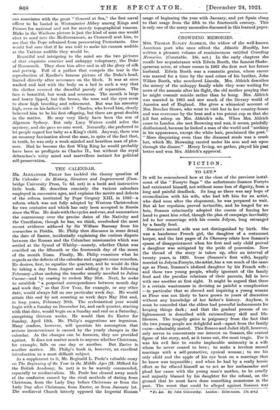THE CALENDAR.
Ma. ALEXANDER PHILIP has tackled the thorny question of The Calendar : its History, Structure and Improvement (Cam- bridge University Press, 7s. 6d. net) in a lucid and instructive little book. He describes concisely the various calendars employed in successive ages, and explains the merits and defects of the reform instituted by Pope Gregory KM. in 1582—a reform which was not fully adopted by Western Christendom for two centuries and which has only been accepted in Russia since the War. He deals with the cycles and eras, and summarizes the controversy over the precise dates of the Nativity and the Crucifixion, though he has, we think, overlooked the most recent evidence adduced by Sir William Ramsay from his researches in Pisidia. Mr. Philip then discusses in some detail the date of Easter, incidentally explaining the curious dispute between the Roman and the Columban missionaries which was settled at the Synod of Whitby—namely, whether Christ was crucified on the fifteenth or the fourteenth day of the moon of the month Nisan. Finally, Mr. Philip examines what he regards as the defects of the calendar and suggests some remedies. He desires, first, to equalize the quarters, and he would do this by taking a day from August and adding it to the following February–rthus undoing the transfer usually ascribed to Julius Caesar—and by ceasing to reckon May 31st. Next, he seeks to establish " a perpetual correspondence between month day and week day," so that New Year, for example, or any other date, would always fall on one particular week day. He would attain this end by not counting as week days May 31st and, in leap years, February 30th. The ecclesiastical year would begin with a Sunday on December 1st, and each quarter, starting with that date, would begin on a Sunday and end on a Saturday, comprising thirteen weeks. He would then fix Easter for Sunday, April 12th. Mr. Philip's suggestions are ingenious. Many readers, however, will question his assumption that serious inconvenience is caused by the yearly changes in the calendar. As the changes can be foreseen, they are provided against. It does not matter much to anyone whether Christmas, for example, falls on one day or another. But Easter is another matter. Mr. Philip's book is, however, an excellent introduction to a most difficult subject.
As a supplement to it, Mr. Reginald L. Poole's valuable essay on The Beginning of the Year in the Middle Ages (H. Milford for the British Academy, 3a. net) is to be warmly commended, especially to mediaevalists. Mr. Poole has cleared away much of the confusion caused by the rival methods of dating from Christmas, from the Lady Day before Christmas or from the Lady Day after Christmas, from Easter, or from January 1st. The mediaeval Church bitterly opposed the Imperial Roman
usage of beginning the year with January, and yet Spain clung to that usage from the fifth to the fourteenth century. This is only one of the many anomalies discussed in this learned paper.


































 Previous page
Previous page